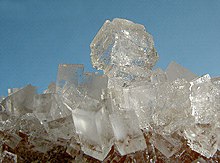Sodium
![]()
This article is about the chemical element. For the car model, see Chrysler sodium; for the Italian death metal band, see Sodium (band).
Sodium is a common chemical element with the symbol Na and atomic number 11. In the periodic table of the elements it is in the 3rd period and as an alkali metal in the 1st IUPAC group or 1st main group. Sodium is a pure element whose only stable isotope is 23Na.
Elemental sodium was first obtained from sodium hydroxide by fused-salt electrolysis in 1807 by Humphry Davy and was called sodium. This name is used in English and French, derivatives of it in the Romance and partly also in Slavic languages. The German name Natrium is derived from the Egyptian netjerj via Arabic نطرون, DMG naṭrūn, natron. Sodium and derivatives thereof are in use in Scandinavia, Dutch, and some Slavic languages besides German. In Japanese, sodium has the German-sounding name Japanese ナトリウム Natoriumu.
Under normal conditions, sodium is a waxy, silvery and highly reactive metal. Because of its strong reactivity, metallic (elemental) sodium is stored under inert conditions, usually in paraffin oil or petroleum, or in hermetically sealed steel drums for larger quantities.
In the Earth's shell, sodium is one of the ten most abundant elements and is found in numerous minerals in the Earth's crust. Seawater contains a significant amount of sodium in the form of sodium ions.
History
The Egyptians in ancient times coined the term netjerj (neter) for the soda obtained from soda lakes. The Greeks adopted this word as the Greek νίτρον nitron, the Romans as nitrium, the Arabs as natrun. Sodium compounds, unlike the elemental metal, have been known for a very long time and have since been extracted from sea water or lakes, mined from earth deposits, and traded. The most important sodium compound, common salt (sodium chloride), was obtained in mines or by drying seawater or saline spring water in salt works. The trade in salt was the basis of wealth for many towns and cities, and in some cases even shaped their names (Salzgitter, Salzburg). Place names such as Hallstatt, Hallein, Halle (Saale), Bad Hall, Bad Reichenhall, Schwäbisch Hall, Schweizerhalle or Hall in Tirol refer to the Germanic name for saline (Hall). Other naturally occurring sodium compounds such as sodium carbonate (soda or natron) and sodium nitrate have also been extracted and traded since ancient times.
It was not until 1807 that Humphry Davy succeeded in producing elemental sodium by electrolysis of molten sodium hydroxide (caustic soda) using voltaic columns as a power source. As he reported to the Royal Society in London on November 19, 1807, he obtained two different metals: the sodium contained in soda ash he called sodium, which is still the common name for the metal in French and English-speaking countries; the other metal he called potassium (potassium). Berzelius proposed the present name sodium in 1811.
.jpg)
Sodium

Humphry Davy, manufacturer of elemental sodium
Occurrence
In the universe, sodium ranks 14th in abundance, comparable to calcium and nickel. In the emitted light of many celestial bodies, including that of the sun, the yellow sodium D-line can be easily detected.
On Earth, sodium is the sixth most abundant element, accounting for 2.36% of the Earth's crust. Due to its reactivity, it does not occur elementally, but always in compounds, the sodium salts. A large store of sodium is seawater. One liter of seawater contains an average of 11 grams of sodium ions.
Common sodium minerals are albite (called sodium feldspar), NaAlSi3O8 and oligoclase (Na,Ca)Al(Si,Al)3O8. In addition to these rock-forming minerals, which belong to the feldspars, sodium occurs in large salt deposits. In particular, there are large deposits of halite (sodium chloride, colloquially often called rock salt), which were formed by the drying up of parts of the sea. These are the most important source for the extraction of sodium and its compounds. Well-known German salt production sites include Salzgitter, Bad Reichenhall, Stade and Bad Friedrichshall.
Besides the common sodium chloride, other compounds occur in nature. Sodium nitrate or sodium nitrate (also called Chilean nitrate) NaNO3 is one of the few natural nitrate minerals. However, because of its good solubility in water, it only occurs in particularly dry regions such as the Atacama Desert in Chile. Before the invention of the Haber-Bosch process, this was the most important raw material for many fertilizers and explosives.
Sodium carbonate Na2CO3 is also found naturally in several minerals. The best known mineral is soda ash Na2CO3 - 10 H2O. It is mined in large quantities and used mainly in glass production.
In addition, a variety of other sodium minerals exist (see also: Category:Sodium mineral). A well-known one is cryolite (ice stone, Na3[AlF6]), which in a molten state serves as a solvent for alumina in aluminum production. Since the only known cryolite deposit is mined in Greenland, cryolite is produced artificially.

Halit
Search within the encyclopedia